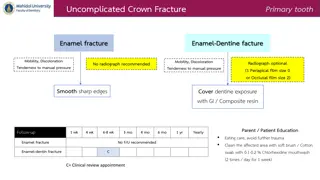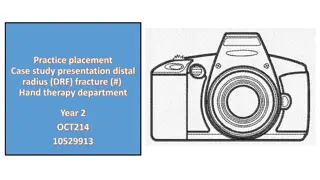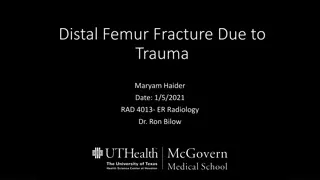Distal Radius Fracture Surgery Patient Information
A distal radius fracture, commonly known as a wrist fracture, is a break in the radius bone near the wrist joint. Surgery may be necessary to realign and stabilize the bone to prevent complications such as stiffness, weakness, and pain. After surgery, patients should watch out for signs of infection, poor bone healing, arthritis, tendon irritation, and other potential issues. Promptly addressing any problems is essential for a successful recovery. Follow-up appointments and physiotherapy may be recommended based on the recovery progress.
Download Presentation

Please find below an Image/Link to download the presentation.
The content on the website is provided AS IS for your information and personal use only. It may not be sold, licensed, or shared on other websites without obtaining consent from the author. Download presentation by click this link. If you encounter any issues during the download, it is possible that the publisher has removed the file from their server.
E N D
Presentation Transcript
Distal Radius Fracture Surgery Patient Information Sheet What is a Distal Radius Fracture? A wrist fracture is a break in the radius bone, close to the wrist joint. In medical terms this is called a distal radius fracture . Occasionally a small chip or fracture can occur in the ulna. Fractures happen when a force is applied to a bone that is greater than the strength of the bone. The angle at which the force is applied and how the strong the force is can affect the type of fracture that happens.. Fractures can happen with a fall, while playing sport or exercising, through a work injury or road traffic accident for example. Why was my injury treated with surgery? The aim of surgery is to realign and stabilise the bone while it is healing. This aims to prevent stiffness, weakness and pain. Some wrist fractures can be treated in a plaster if the bone is not displaced, you accept the displacement or surgery would be too risky. Surgery involves the bone being held with either pins that go through the skin (k-wires) or by a plate and screws that sit under the skin and muscle on the bone. The type of surgery carried out depends on what is needed to safely fix your fracture. It is carried out with either a general anaesthetic (where you are asleep) or a regional anaesthetic (where you are awake but can t feel your arm). Surgery usually takes 30-60 minutes. What happens after surgery? You will be seen back at the fracture clinic 2 weeks after your surgery. This should have been arranged with you before you were discharged from the hospital. Closed Reduction and K-Wire Fixation Surgery You will be seen by the fracture clinic staff, they will remove your cast, check your wounds, hand function, sensation and blood supply. They will then send you to get an X-ray of your wrist and this will be reviewed by one of the surgeons. If there are no concerns then you will be given a new cast. You will then be given a further appointment for 3 weeks later. At this appointment the cast will be removed and you will be given a removable splint to where for 1 week. The wires will be removed in the clinic. This is not safe and is usually not painful. Open Reduction and Internal Fixation Surgery You will be seen by the fracture clinic staff, they will remove your dressings or cast, check your wounds, hand function, sensation and blood supply. They will then send you to get an X-ray of your wrist and this will be reviewed by one of the surgeons. If there are no concerns then you will be given new cast, removable splint or no splint depending on your injury. You will then be given a further appointment for 4 weeks later. At this appointment the splint/cast will be removed. Patient Initiated Return Before you are discharged from hospital you will be given advice on problems to watch out for and advice on hand and wrist exercises. You will be given this patient information sheet. You should read through this leaflet closely as it will tell you about what you should expect for your recovery and exercises to carry out. It will also tell you how to get arrange a further appointment should you have any problems. Once you have finished at your final appointment, if you develop a problem related to your wrist fracture or surgery, you can contact the clinic and arrange a new appointment yourself. You do not need to contact your GP to do this.
Distal Radius Fracture Surgery Patient Information Sheet What problems should I look out for? Some problems patients can develop after surgery are infection, poor bone healing, arthritis, tendon irritation, complex regional pain syndrome and carpal tunnel syndrome. These problems can cause you to feel unwell, develop pain, stiffness, swelling, pins & needles or weakness. Infection You might feel unwell or feverish with increased pain, swelling or stiffness in the wrist. Sometimes the wound can start to leak. If you develop any of these problems contact the clinic using the contact details below. If it is out-with clinic hours and you feel unwell then go to your local Emergency Department. Pain This can be caused by many problems. If your pain is getting worse at any time after surgery, or you still have moderate or severe pain 12 weeks after surgery then contact the clinic using the details below. Stiffness If you are having problems with wrist stiffness that is affecting your ability to do things at 12 weeks after surgery you should arrange physiotherapy using the details below. Swelling If you have new or worse swelling after you have been to your final clinic appointment then contact the clinic using the details below. Tendon Irritation If you are getting pain or a grating/cracking sensation when you are trying to move one of your fingers or thumb then allow it to rest for 1-2 weeks. If the pain doesn t go away or gets worse then contact the clinic using the details below. Carpal Tunnel Syndrome If you develop pins and needles, or numbness in any of your fingers that doesn t go away after an hour, contact the clinic using the details below. If it is severe and the hand becomes numb and it is out-with the clinic hours, attend your local emergency department. If you have a problem related to your wrist fracture or surgery that is not listed here but you would like to see someone about it then please contact the clinic using the details below. When can I return to work? This depends on the demands of your job. It is likely that you will require 2-3 weeks off to recover from the surgery and allow the discomfort to settle. If you have an office job, returning to work after this for light duties should be possible, but you should avoid anything which makes your wrist uncomfortable, such as prolonged typing. For manual work requiring lifting, you will need at least 6 weeks off, which may be longer depending on the extent of your injury. When can I return to driving? You should not drive while you are needing to wear a cast or splint. After this you can drive when you are able to control your vehicle without distraction. This is your decision, you can discuss this with your doctor or physiotherapist if you are unsure. You must be safe and in control of the vehicle. The law is very clear that you have to be able to prove to the police that you are 'safe' to drive, so it is entirely your own responsibility and we cannot give you permission to drive. When can I return to sport? You should only return to contact sport 12 weeks after your injury. Other sport may be earlier but you should take the advice of your doctor or physiotherapist who will guide you. Do I need Physiotherapy? Most patients don t need physiotherapy. If you carry out the hand and wrist exercises in this leaflet your movement will probably return to normal. If you are having problems with stiffness and this is affecting what you can do 12 weeks or more after surgery, please contact the physiotherapy department below or arrange this with your GP.
Recovery from surgery What will my recovery be like? Below is a rough guide of what most patients will be able to do after wrist fracture surgery. Everyone is different and some people may take longer or shorter to be able to do these things. If you are unsure please discuss them with your nurse or surgeon. Weeks since surgery Plan You will be in a cast, splint or bulky bandage depending on your injury Use the sling for the first few days if the arm is painful. Move your fingers often. Carry out stage 1 exercises 0-2 You can use the arm for simple tasks as pain permits. Depending on your injury and if you are comfortable the nurse in clinic may remove your cast, splint or bulky bandage. Continue stage 1 exercises Return to desk based work if required and comfortable. 2-6 The fracture is united (healed) You can begin to resume normal activity but be guided by any pain you are experiencing. Carry out day to day activities. Carry out stage 2 exercises Heavy tasks, heavy lifting or sport may cause some initial discomfort. 6 -12 Return to manual work, sport and heavy activities. you are still experiencing significant pain and swelling then please contact the Fracture Care Team for advice. 12+
Hand and Wrist Exercises Exercises Stage 1 (Week 0-6) Finger exercises: Keep your fingers moving whilst you are in the splint. Elbow Bend to Straighten: Bend and straighten your elbow as far as you can without pain. You should not feel more than a mild to moderate stretch. You can use your other arm to assist if necessary. Repeat 10 - 15 times if there is no increase in pain. Forearm Rotations: Begin this exercise with your elbow at your side and bent to 90 degrees. Slowly turn your palm up and down as far as you can go without pain. You should not feel more than a mild to moderate stretch. You can use your other arm to assist if necessary. Repeat 10 - 15 times if there is no increase in pain. Exercises Stage 2 (Week 6 onwards) Finger and wrist flexion and extension Open and close your hand as shown 10-15 times. Then move your wrist up and down 10-15 times. After a few days, hold a soft ball / ball of socks. Squeeze the ball as hard as possible without pain. Hold for 5 seconds and repeat 10 times. Further Information and contact details Contact Details Queen Elizabeth University Hospital main switchboard 0141 211 1100 Queen Elizabeth University Hospital Fracture Clinic 0141 452 3210 (Monday Friday, 09:00 16:00) Victoria ACH Fracture Clinic 0141 347 8754 (Monday Friday, 09:00 16:00) Appointments booking office 0141 347 8347 (Monday Friday, 08:00 20:00) Physiotherapy 0141 452 3713 (Monday Friday 8.30- 1600) Further information is available at https://www.nhs.uk/conditions/broken-arm-or-wrist/























